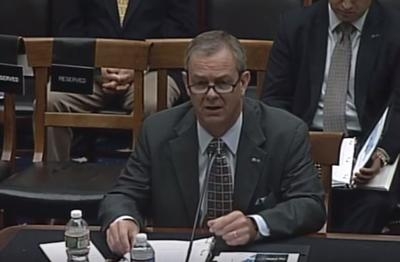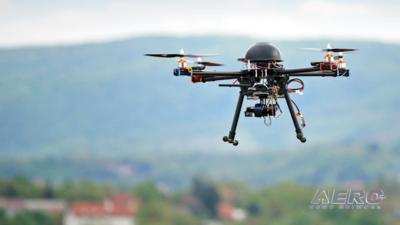Tue, Aug 30, 2016
New FAA Rule Allows More Businesses And Innovators To Fly, Unlocks Economic Benefits
With regulations governing civil and commercial operations of unmanned aircraft systems (UAS) now in effect, more businesses and innovators are poised to take flight and unlock the tremendous economic benefits of the technology, AUVSI President and CEO Brian Wynne said at a press conference Monday. Wynne joined U.S. Department of Transportation Secretary Anthony Foxx and FAA Administrator Michael Huerta to mark the historic moment that has opened up the U.S. skies to more commercial UAS.

“The United States has been a pioneer in aviation since the Wright Brothers first took to the skies more than 100 years ago,” Wynne (pictured in file photo) said. “Today we’ve reached another significant milestone. With the small UAS rule now in effect, the commercial drone industry is cleared for takeoff.”
Wynne added that the UAS industry is poised to be one of the fastest-growing in American history. AUVSI’s economic report has forecasted that the UAS industry will create more than 100,000 jobs and generate more than $82 billion for the economy in the first decade following UAS integration into the national airspace.
“The small UAS rule establishes a clear regulatory framework and helps to reduce many barriers to civil and commercial operations,” Wynne said. “In reducing those barriers, the rule allows businesses and innovators to harness the tremendous potential of UAS and unlock the many economic and societal benefits the technology offers.”
Wynne pointed to the flood of exemption requests the FAA has received as strong evidence that the commercial UAS market is poised for incredible growth. In Sept. 2014, the FAA started granting exemptions for certain low-risk commercial UAS applications under Section 333 of the FAA Modernization and Reform Act of 2012.
AUVSI analyzed the more than 5,500 exemptions approved by the FAA before the small UAS rule went into effect. The results highlight both the wide number of industries adopting the technology, as well as foreshadow the exciting potential of the industry.
Specifically, AUVSI’s report finds:
- The approved exemptions cover 42 types of business operations. Aerial photography was the most popular with companies noting this application 4,594 times. Real estate was the next most popular, with operators requesting this application 3,274 times, followed by aerial inspection at 2,976.
- Exemptions were approved for operators in all 50 states and Puerto Rico. California received the most with 639, followed by Florida with 571 and Texas with 468.
- Most commercial UAS operators are small businesses. About 90 percent of the operators and companies receiving exemptions make less than $1 million in annual revenue and have fewer than 10 employees.

There is still work to be done in order for businesses to take full advantage of UAS technology, and the UAS industry continues to look toward the future to make full UAS integration a reality. In August, the AUVSI Foundation partnered with the White House Office of Science and Technology Policy for a workshop on drones and the future of aviation. A report on insights from the government, academic and industry representatives who participated in the workshop is expected to be released soon.
“We look forward to continued industry-government collaboration that advances UAS research and paves the way for a true, holistic plan for full UAS integration, including beyond line of sight operations, flights over people, access to higher altitudes and platforms above 55 pounds,” Wynne said.
(Source: AUVSI news release)
More News
DETRESFA (Distress Phrase) The code word used to designate an emergency phase wherein there is reasonable certainty that an aircraft and its occupants are threatened by grave and i>[...]
Aero Linx: The International Association of Missionary Aviation (IAMA) The International Association of Missionary Aviation (IAMA) is comprised of Mission organizations, flight sch>[...]
Also: EP Systems' Battery, Boeing SAF, Repeat TBM 960 Order, Japan Coast Guard H225 Buy Despite nearly 100 complaints totaling millions of dollars of potential fraud, combined with>[...]
Also: Viasat-uAvionix, UL94 Fuel Investigation, AF Materiel Command, NTSB Safety Alert Norges Luftsportforbund chose Aura Aero's little 2-seater in electric trim for their next gli>[...]
Also: Moya Delivery Drone, USMC Drone Pilot, Inversion RAY Reentry Vehicle, RapidFlight UAVOS has recently achieved a significant milestone in public safety and emergency services >[...]
 ANN's Daily Aero-Term (04.26.24): DETRESFA (Distress Phrase)
ANN's Daily Aero-Term (04.26.24): DETRESFA (Distress Phrase) ANN's Daily Aero-Linx (04.26.24)
ANN's Daily Aero-Linx (04.26.24) Airborne 04.22.24: Rotor X Worsens, Airport Fees 4 FNB?, USMC Drone Pilot
Airborne 04.22.24: Rotor X Worsens, Airport Fees 4 FNB?, USMC Drone Pilot Airborne 04.24.24: INTEGRAL E, Elixir USA, M700 RVSM
Airborne 04.24.24: INTEGRAL E, Elixir USA, M700 RVSM Airborne-NextGen 04.23.24: UAVOS UVH 170, magni650 Engine, World eVTOL Directory
Airborne-NextGen 04.23.24: UAVOS UVH 170, magni650 Engine, World eVTOL Directory




